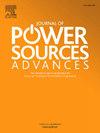Formulating PEO-polycarbonate blends as solid polymer electrolytes by solvent-free extrusion
IF 4.6
Q2 CHEMISTRY, PHYSICAL
引用次数: 0
Abstract
Liquid electrolytes are currently state-of-the-art for commercial Li-ion batteries. However, their use implicates inherent challenges, including safety concerns associated with flammability, limited thermal stability, and susceptibility to dendrite formation on the lithium metal anode, that can compromise the battery lifespan. Solid-state polymer electrolytes offer an alternative to conventional liquid electrolytes, aiming to mitigate safety, stability, and performance drawbacks. This study investigates the preparation and the comprehensive characterization of polyethylene oxide (PEO) and polycarbonate (PC) blends obtained through extrusion process. The process is solvent-free and easily scalable at the industrial level; it grants the efficient dispersion and mixing of PEO and PC. Blends at different ratios of PEO (Mw of 4 × 105 and 4 × 106 g mol˗1) and two types of PCs (namely, polyethylene and polypropylene carbonate) including lithium bis(trifluoromethanesulfonyl)imide (LiTFSI) are prepared. Optimization and investigation of the relative effects between the application of different PCs and the variable ratios of PEO/PCs on the mechanical, morphologic and electrochemical properties of the final polymeric membranes is carried out for future applications of these systems, as efficient electrolytes in all-solid-state lithium batteries.
通过无溶剂挤压法将聚醚砜-聚碳酸酯混合物配制成固体聚合物电解质
液态电解质是目前最先进的商用锂离子电池。然而,使用液态电解质会面临固有的挑战,包括与易燃性相关的安全问题、有限的热稳定性以及在锂金属阳极上形成枝晶的易感性,这些都会影响电池的使用寿命。固态聚合物电解质是传统液态电解质的替代品,旨在缓解安全性、稳定性和性能方面的缺陷。本研究调查了通过挤压工艺获得的聚氧化乙烯(PEO)和聚碳酸酯(PC)混合物的制备和综合表征。该工艺不含溶剂,易于扩展到工业水平;可实现聚环氧乙烷和聚碳酸酯的高效分散和混合。制备了不同比例的 PEO(Mw 分别为 4 × 105 和 4 × 106 g mol˗1)和两种 PC(即聚乙烯和聚丙烯碳酸酯)(包括双(三氟甲烷磺酰)亚胺锂(LiTFSI))混合物。优化和研究了不同 PC 的应用和 PEO/PC 的不同比例对最终聚合物膜的机械、形态和电化学性能的相对影响,以便将来将这些系统用作全固态锂电池的高效电解质。
本文章由计算机程序翻译,如有差异,请以英文原文为准。
求助全文
约1分钟内获得全文
求助全文

 求助内容:
求助内容: 应助结果提醒方式:
应助结果提醒方式:


